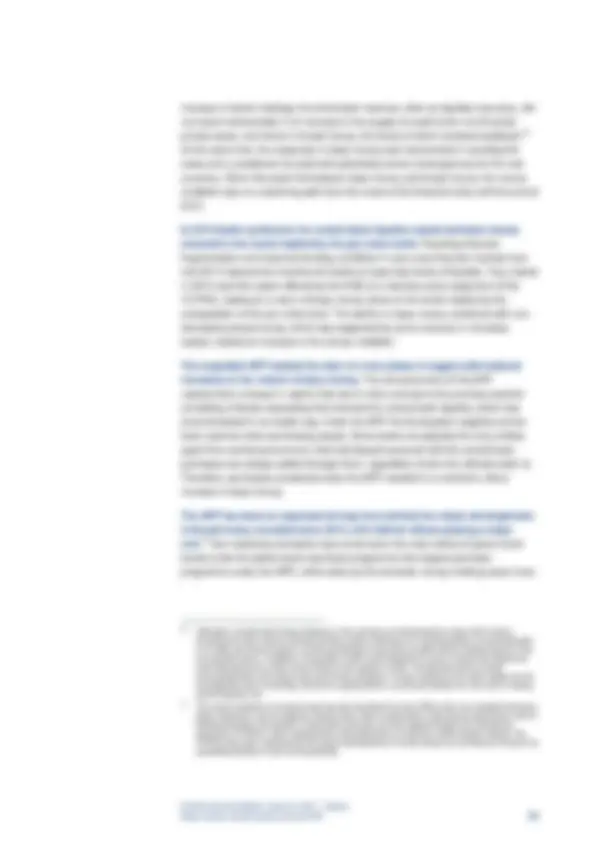




Study with the several resources on Docsity

Earn points by helping other students or get them with a premium plan


Prepare for your exams
Study with the several resources on Docsity

Earn points to download
Earn points by helping other students or get them with a premium plan
Community
Ask the community for help and clear up your study doubts
Discover the best universities in your country according to Docsity users
Free resources
Download our free guides on studying techniques, anxiety management strategies, and thesis advice from Docsity tutors
In the pre-crisis period, base money developments largely reflected changes in currency in circulation and required central bank reserves (see Chart A). In.
Typology: Slides
1 / 4

This page cannot be seen from the preview
Don't miss anything!



ECB Economic Bulletin, Issue 6 / 2017 - Boxes
The significant expansion in base money induced by the asset purchase programme (APP) has attracted growing public attention. This box provides an overview of recent developments in base money^34 and discusses to what extent they have had implications for broad money^35.
In the pre-crisis period, base money developments largely reflected changes in currency in circulation and required central bank reserves (see Chart A). In periods when interbank markets are functioning normally, the Eurosystem provides the central bank reserves in euro needed by the banking system on aggregate, which are then traded among banks and thereby redistributed within the banking system as necessary. The aggregate demand for central bank reserves is thus effectively accommodated by the Eurosystem with very limited levels of excess reserves. In the pre-crisis period, base money developments in the euro area were therefore largely a reflection of changes in currency in circulation and required central bank reserves.
Chart A Base money (stocks in EUR billions)
Source: ECB. Note: The latest observation is for August 2017.
Prior to the financial crisis, base money and broad money developments were unfolding along similar trends (see Chart B). The growth in base money in the
(^34) Base money consists of banknotes in circulation, the deposits that credit institutions are required to hold in their current accounts with the Eurosystem in order to cover the minimum reserve requirement (required central bank reserves) and credit institutions’ holdings of highly liquid deposits with the Eurosystem over and beyond the level of required central bank reserves (excess central bank reserves and recourse to the deposit facility). (^35) Broad money, or M3, consists of very liquid liabilities of domestic MFIs held by the money-holding sector (i.e. non-MFIs resident in the euro area, except central government): currency in circulation, overnight deposits, deposits with maturities of up to two years, deposits redeemable at notice of up to three months, repurchase agreements, money market fund shares/units and MFI debt securities of up to two years. From a monetary analysis perspective, broad money is relevant because it is associated with the total resources available in the economy for the purchase of goods, services and non- monetary assets as well as for investment expenditures.
0
500
1,
1,
2,
2,
3,
3,
1999 2001 2003 2005 2007 2009 2011 2013 2015 2017
banknotes in circulation current accounts (including minimum reserve balances) deposit facility
ECB Economic Bulletin, Issue 6 / 2017 - Boxes
euro area mirrored that of broad money, since the injection of central bank reserves in that period was demand-driven, i.e. determined by currency in circulation and the evolution of banks’ reserve requirements, which in turn depended on the evolution of banks’ short-term liabilities (deposits and debt securities with a residual maturity of up to two years). As a result, the money multiplier (the ratio of broad money to base money) was rather stable.
Chart B Base money and the money multiplier
(left-hand side: index: 1999=100; right-hand side: money multiplier)
Source: ECB. Notes: The money multiplier is the ratio of broad money to base money. The latest observation is for July 2017.
Since the financial crisis, base money has been increasingly driven by Eurosystem monetary policy operations. In line with the responses of all major central banks to the financial crisis, the volume of monetary policy operations undertaken by the Eurosystem increased substantially from 2007 onwards and in particular after September 2008. In a situation of malfunctioning money markets and liquidity stress on banks’ balance sheets, the Eurosystem supplied central bank reserves to each counterparty elastically at a level well above the banking system aggregate demand, through fixed rate tenders with full allotment. Moreover, in 2009 the first programme of outright purchases of covered bonds (CBPP1) was launched. The resulting increase in excess central bank liquidity was mirrored by a significant expansion of base money (see Chart A). The volume of monetary policy operations increased again sharply in the second half of 2011, mainly as a consequence of the two longer-term refinancing operations (VLTROs) with a three-year maturity conducted in December 2011 and February 2012, and, to a lesser extent, outright purchases of securities under the CBPP2. As a result of these operations, excess reserves and, therefore, base money displayed a further sizeable increase.
Since the introduction of non-standard measures, broad money has stopped closely mirroring developments in base money. Since 2008, the trends in base money and broad money have decoupled, as the expansion in base money due to non-standard measures has not supported a similar uptrend in monetary holdings outside the banking sector. In the context of considerable financial fragmentation, economic uncertainty and weak credit demand, it was not surprising that the
3
6
9
12
15
0
200
400
600
800
1999 2001 2003 2005 2007 2009 2011 2013 2015 2017
3-year LTROs Asset purchase programme with full allotmentFixed rate tender
base money broad money – M multiplier (right-hand scale)
ECB Economic Bulletin, Issue 6 / 2017 - Boxes
been moderate, implying a contained direct impact of the APP on broad money.^38 A large part of the effects of the APP on broad money have materialised via indirect effects. First, indirect effects arise from the portfolio rebalancing that the programme is intended to bring about. Moreover, banks have expanded loans to domestic firms and households, implying an increase in the deposits held by the euro area money- holding sector. Some banks have also used the increased liquidity at their disposal to pay down their more costly liabilities. Further indirect effects of the APP on broad money have materialised via a wide set of channels through which the APP has influenced financial markets and economic activity. The APP has indeed resulted in a broad easing of financing conditions and favourable wealth effects, crucially supporting the recovery in lending and economic growth. The money multiplier has been declining since the start of the APP, mechanically reflecting the proportionately larger positive impact of the programme on base money than on broad money. While the former displays a direct relationship with the purchases, the latter is mainly affected via complex indirect effects, as discussed above.
(^38) Direct effects of the APP on broad money only arise when purchases are made from the euro area money-holding sector. For more details, see the article entitled “The transmission of the ECB’s recent non-standard monetary policy measures”, Economic Bulletin , Issue 7, ECB, 2015. For more details on the PSPP purchases by sector, see the box entitled “Which sectors sold the government securities purchased by the Eurosystem?”, Economic Bulletin , Issue 4, ECB, 2017.